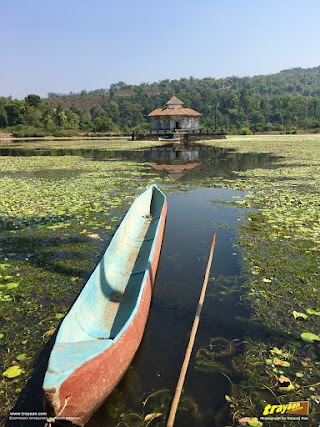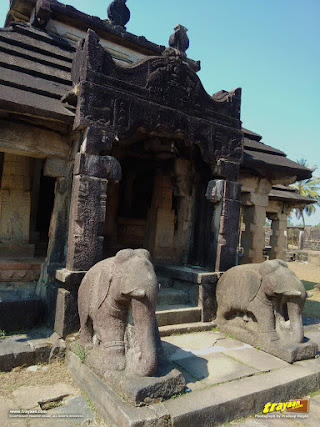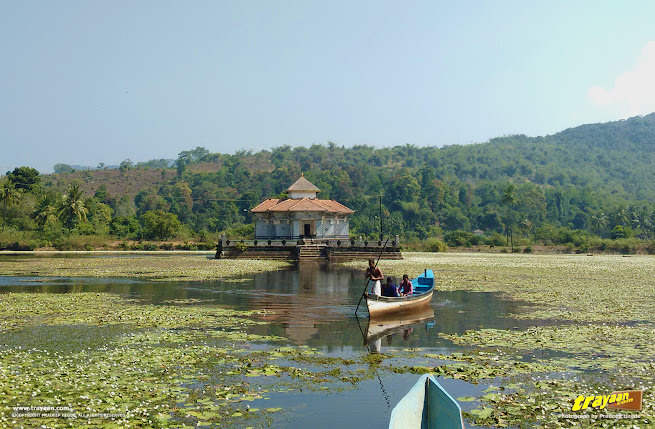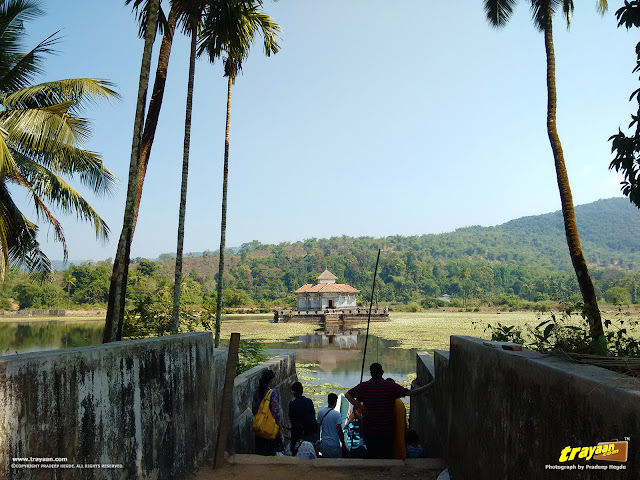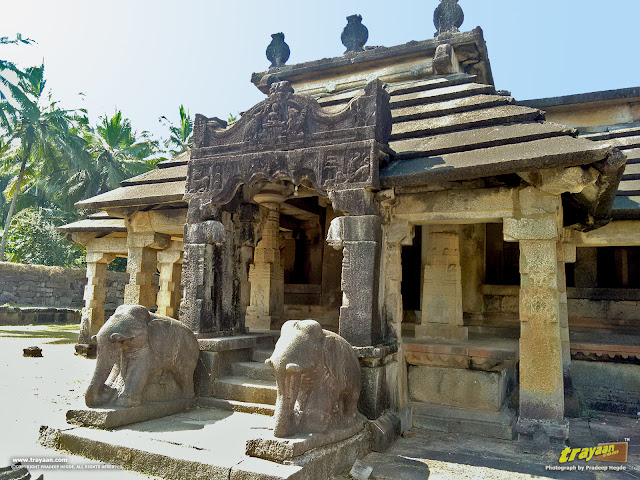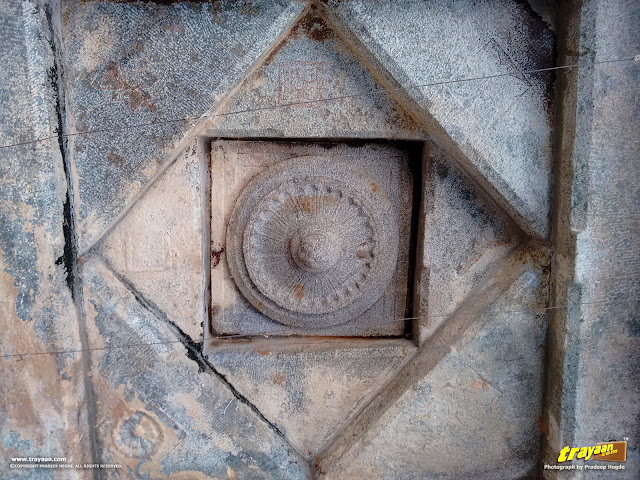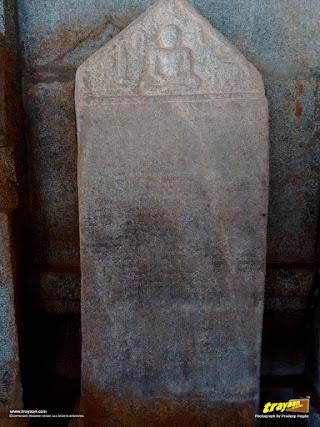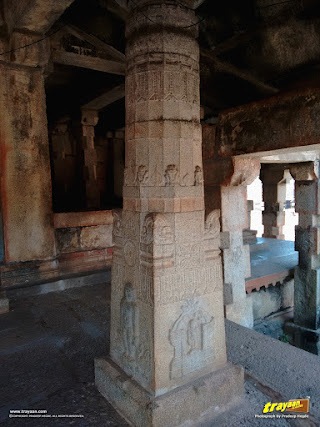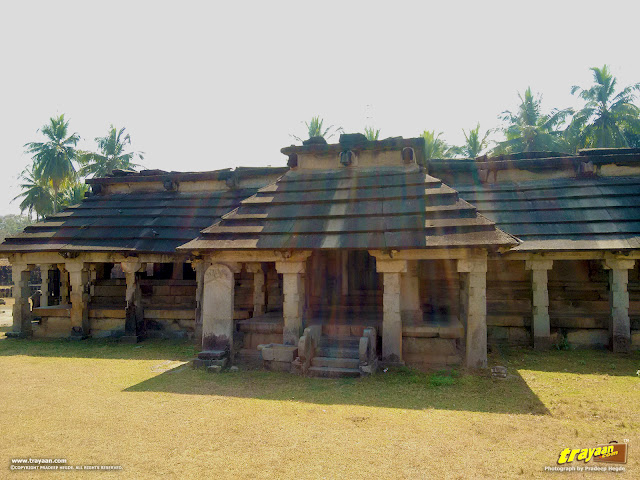The Lake Temple and other Jain Temples in Varanga, Karkala.
Varanga, a small village in Karkala taluk of Udupi district in Karnataka, is home to ancient Jain temples that are eight hundred to thousand years old.
Here's an account of our visit to this idyllic village of Varanga and its ancient heritages, including the Jain temples known as the Kere Basadi (i.e., lake temple) and Shri Neminatha Basadi.
Jump to:
| About Varanga, and Our Visit to Jain Temples of Varanga| Brief History of Varanga
Varanga Jain Temples
| Kere Basadi – The Lake Temple of Varanga - Shri Parshwanatha Basadi
| Shri Neminatha Basadi of Varanga
| Tips for Travellers
| Getting There & Transportation | Food & Accommodations | Best times to visit
| Location Map | Get Directions | Nearby Attractions | Glossary
About Varanga
Varanga is an idyllic village in Karkala taluk of Udupi district, in Karnataka. Varanga houses the picturesque 850 year old Lake Temple (Kere Basadi) dedicated to the Jain Lord Shri Parshwanatha and the thousand-plus year old Neminatha temple dedicated to the Jain Lord Shri Neminatha.
This serene hilly village of Varanga and its Jain temples are surrounded in lush greenery, at about 24 kilometers north of the Karkala town, along the sylvan Karkala-Agumbe road. Varanga is worth visiting if you’re travelling by this way.
Varanga has three Basadis, all close to each other – the Neminatha Basadi (~1200 year old), Chandranatha Basadi (~1000 year old) also known as Mathada Basadi (a monastery), and the ~850 year old Parshwanatha Basadi (also known as the Kere Basadi, beautifully situated amidst a lake full of water lilies).On our way to Udupi, we decided to visit Varanga, and we reached it passing by Moodabidri and Karkala on the way. Before proceeding with these beautiful heritages of Varanga, let us briefly have a look at its history.
Brief History of Varanga
The history of Varanga goes back to the ancient times, and it appears to be one of the earliest Jain settlements in this region. The Neminatha Temple of Varanga is said to have been established by a king called Varanga Raya. The Jain Matha or monastery of Varanga is a branch of the Humcha Jain Matha and is said to have belonged to an ancient tradition.Humcha (also known as Hombuja) is an ancient Jain Heritage Centre in the Shimoga district of Karnataka, with its history dating back to the 7th century CE. Hombuja was the capital of the Sāntara, a Jain dynasty in Karnataka who were feudatories of Kalyani Chalukya, Rashtrakoota, Hoysala, and later, the Vijayanagara Kingdom.
Epigraphic records indicate that Alupas had close relations between the Sāntaras, of both rivalry and alliance, which is evident by the inscriptions at Varanga. The insciption at Neminatha Basadi indicates that King Kundana of the Santara lineage who had assumed control of the Alupa line, had restored a grant to this temple.
Despite being a feudatory of the Vijayanagar kings, the Santaras enjoyed a large measure of autonomy. Karkala was under the Alupas, who later ceded it to the Santaras. The rulers of Karkala were called Bhairarasas, with King Veera Bhairarasa (1390 CE-1420 CE) as the first prominent king of the dynasty. However, the Varanga temples were built at least a couple of centuries before the Bhairarasas, i.e., they predate the ones built by the Jain rulers of Karkala and Moodabidri.
According to one of the inscriptions in the premises of Varanga's Neminath Basadi, a 13th century inscription, mentions that a Jain Mutt (A Mutt, or Matha means a monastery) existed here even before the installation of that inscription. This monastery is believed to exist since 8th or 9th century CE.
An inscription in the premises of Neminatha Basadi (also called Nemishwara Basadi) records the excavation of the Varanga lake by the queen of King Kulashekhara, who was King Kundana's predecesor. Kulashekhara's rule existed from 1160 to 1220 CE. The Kere Basadi or Lake Temple was later built amidst this man-made lake. King Kundana was a king from the Santara lineage.
References: [1][2][3][4][5]
Since the temples and monastery were built during the period of Santaras, the Varanga Raya could probably have been one of them or someone who was affiliated to them and followed their traditions.
Kere Basadi – The Lake Temple of Varanga
Popularly known as the Kere Basadi (meaning the Lake Temple in Kannada), this temple is about 850 years old and it is dedicated to the Jain Lord Parshwanatha (Pārśvanātha).
This is also a Chaturmukha Basadi, meaning a four-faced symmetrical Jain temple, just like the Aane Kere Basadi (Elephant Lake Temple) of Karkala, which is another Chaturmukh temple situated amidst a lake. However, the Lake Temple of Varanga can be approached only by the means of a boat, unlike the Aane Kere Lake Temple of Karkala, which has an approach pathway to it.
As already mentioned in the Brief History section above, this is a man-made lake which was excavated by the queen of King Kulashekhara who regined between 1160 to 1220 CE.
Shri Parshwanatha Basadi, popularly known as the Kere Basadi of Varanga beautifully stands amidst a serene lake full of water-lilies. The main deity here is the 23rd Tirthankara, Shri Parshwanath. Just like other Chaturmukha Basadis, the images of the Jain deities here are installed facing four different entrances facing four directions – the north, east, south, and west. All the images of these deities -- Parshwanatha, Shanthinatha, Ananthanatha and Neminatha, are in the Kayotsarga posture. An image of Lord Parshwanath’s Yakshi, Goddess Padmavathi, is installed before it.
Padmavati is an ancillary deity, the serpent goddess who attends upon Lord Parshwanatha.[5]
We took the tickets for the boat ride and visit, at a counter before the Mathada Basadi, or Chandranatha Basadi near the banks of the lake, which also serves as the Jain monastery. The Chandranatha Basadi houses a 1000 year old sculpted image of the main deity Chandraprabha, the 8th Jain Tirthankar.
Taking the tickets (10 rupees per head), we went down to the lakeside for the boat. We had to wait a bit for the boat which was already at the Lake Temple along with some devotees. We took some pictures while we were waiting, and as the temple priest brought the boat back to the banks of the lake where we were waiting.
Some more tourists joined us on the boat. It’s a small wooden boat and one has to be careful, as rocking the boat can cause it to capsize.
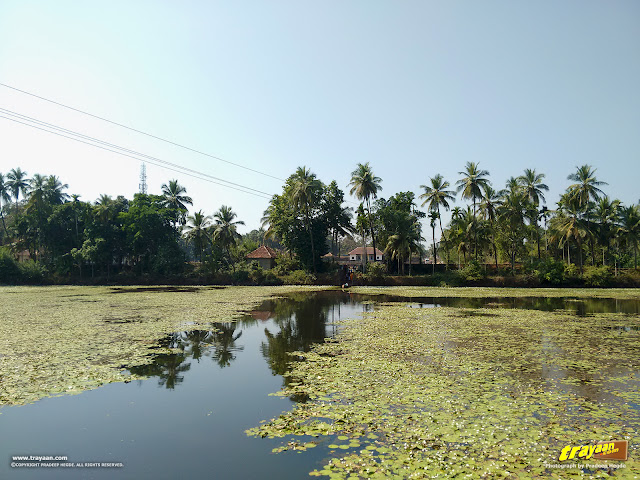
We spent a little time on the small island of the Lake Temple. There are some fishes that come to its banks, and there were traces of puffed rice that devotees might have used to feed it with. There was also a freshwater turtle and a water snake in the lake! So be careful here, and don’t enter the lake waters, or try put your hands in it.
Although about 850 years old, this temple looks renovated, possessing a modern look due to the large marble tiles that surround the outer wall, along with the modern tiled roofing. I remember watching a T.V programme on this temple many years ago, perhaps a decade ago, where it had plain whitewashed walls and had a sort of an old feel to it, even though it had the modern tile roofing.
But if you look closely at the temple towards its eaves, the frieze projections look old. Also the pitched roofing above the central section, with a kalasha on its top, looks old; which rises above the modern-tiled pitched roofing that surrounds it.
We loved the peace and quiet at this place; being situated amidst the serene lake just adds to its idyllic charm. Here's a small video we made on the Lake Temple.
Even after 850 years, active worship still takes place in this basadi, with devotees visiting it. The devotees believe that performing the worship rituals here brings good luck and prosperity.
Shri Neminatha Basadi of Varanga
Before visiting the Kere Basadi, or the Lake Temple, we visited the Neminatha Basadi, also called as the Hiré Basadi. Neminatha Basadi lies opposite to the Lake Temple Parshwanatha Basadi, at a height, and across a small field. This 1200 year old temple dedicated to Neminatha, or Nemishwara, is still functional, with continuing active worship and religious rituals.This is an east-facing temple set in a large enclosure surrounded by high walls with two entrances. The main entranceway, at the east side of the enclosure walls of the temple's courtyard, through which we entered, is a quite large entrance porch which opens up to the inner courtyard of the temple.


(Not to be confused with the Neminatha Basadi Jain Temple of Karkala, which is also known as Hiré Basadi!)
The Neminatha Basadi of Varanga majestically stands in the courtyard, with a high metallic deepasthamba (a lamp column) before it. Two large beautifully sculpted elephant balustrades stand in the front, just before the impressive granite entranceway to the steps leading to the front porch (mandapa or mantapa) of the temple. The temple is made of granite rocks, which preserves its exquisite antique look. Despite its rather modest appearance, sans a lot of intricate carvings to adorn it, this 1200 year old temple is quite large, and stands elegantly in its spacious courtyard.
This entranceway is made of rather austerely carved granite columns and pieces joined together. There’s an impressively carved arch-like section made out of a single granite slab above it, which consists of bas-relief sculptures. A scene of two elephants garlanding a deity is carved on the top central portion of this section.
Immediately above this, there is a sculpted relief image of a demon face, which is placed for warding off evil looks. These demon-like-faces are typically found above Jain temples across Karnataka. Here it is made out of the ornate granite slab of the entranceway; whereas in temples like the Savira Kambada Basadi (thousand pillared temple) of Moodabidri and some other Basadis of Karkala, they’re made of metal, probably bronze or brass.

This temple, like many other Jain and Hindu Temples of this side, features the typical slanted stone roofing as shades to the porch and the raised platform surrounding the temple. You can see this kind of roofing in the temples of Karkala, Moodabidri, Barkur, Udupi and some other places. The top of this temple is a plain flat roof, like the Chaturmukha Basadi of Karkala, sans the wooden gabled roofing, such as the one above the Savira Kambada Basadi (Thousand Pillared Temple) of Moodabidri.
Entering the front porch through this ornate entranceway, we came before the doorway to the temple, which was closed. There are a couple of Halegannda (Old-Kannada) inscription here, in the front. Another Halegannada inscription stands at the side entrance porch to the temple, on the north side. There are two entrances to the inner sanctums of this temple. The main one to the east, inside the front or east entrance porch; and the side entrance to the north, through the north entrance porch.
An early eighteenth century inscription indicates that Kundana, a king from the Santara lineage had restored a grant to the Nemishwara Basadi (or the Neminatha Basadi), to renovate this entrance hall or porch. [1]
The official signboard on the temple, beside one of the halegannada inscriptions, names this temple as "Shri Bhagavan Neminath Mandir" in Hindi, and as "Shri Nemishwara Swami Basadi" in Kannada. Apart from a couple of columns in the front porch, just after the ornate entranceway, all the supporting columns outside the temple are plain and sans any ornate carvings. As the temple was closed at the time of our visit, we could not see inside on that day.
The Neminatha Basadi houses bronze idols of 24 Tirthanakaras in kayotsarg posture. A 5 feet high shiny-black image of Lord Neminath, the 22nd Tirthankara, seated in a padmasana position, is housed in the main sanctum. Neminatha Swami is considered as the village god (graamadevaru, or graamdevta) of Varanga. According to an inscription dating back to 1424 CE, King Devaraya of Vijayanagara granted the land to the village of Varanga to run the temple.[2]
A towering manasthambha stands outside the enclosure, towards north and just outside the small northern gate to the temple’s enclosure walls. It stands majestically beside the road that passes by the enclosure walls.
After spending good time here, we moved on to our next destination, towards Udupi and the St. Mary's island. We'll be back with that in our next travel story.
Tips for Travellers
- The Lake Temple can be visited only by the means of a boat. You have to buy tickets for that at the entrance porch of Mathada Basadi, or Chandranatha Basadi near the banks of the lake. They are all marked in the below location map.
- You must maintain decorum, as these temples are places of active worship. Do not shout or create a nuisance. This is not a place for a picnic. Keep silence and behave respectfully.
- Visit if you love nature and places of history, culture and heritage; or if you’re spiritual and want to visit as a pilgrim. If you’re looking for a place to have fun, this is not the place for you.
- Be careful on the boat and don’t be fidgety. Do not panic or rock the boat. The lake is quite deep and it is inhabited by snakes. So, don’t put your hand in the water too. It’s a small boat, and there’s no saving you if it capsizes, especially if you don’t know to swim. If children accompany you, warn them beforehand to behave.
Getting there & Transportation
Varanga is ~24 Kilometres from Karkala town, ~34 kilometres from Manipal, ~40 kilometres from Udupi town, and ~79 kilometres from Mangaluru. There are buses that ply by this route from Karkala, Moodabidri and Mangaluru, which go towards Agumbe. It is better and convenient if you use a hired vehicle as it saves you a lot of time by avoiding waiting for the bus, and helps you cover other nearby places of interest.
Food & Accommodations
There aren’t any great places of food or accommodation here. You will have to plan to stay at either Udupi, Manipal, Karkala, or Mangaluru, and then travel to Varanga. Plan in such a way that you cover Varanga by afternoon and reach one of the following towns – Karkala, Udupi, Manipal, or Moodabidri, for lunch.
If you have a day or two, you can plan a trip around the districts Dakshina Kannada and Udupi appropriately, including Varanga in your itinerary.
Location Map for the Temples of Varanga
Best Times to visit
During the winter, between October to February or March, before the summer heat begins. It gets extremely hot and humid during summer (March/April to May/June). If you simply love the monsoon rains, go ahead in rainy season (around June to September). But keep an eye on the weather in the rainy season, as the roads this time may be bad.Basadi (also spelled and called Basthi) – A Jain Temple.
Mutt, Matha (Sanskrit: मठ) – A monastery or a religious establishment.
Tirthankara (also spelled Thirthankara, etc) – A ford-maker, a teacher of Jainism, also called Jina (meaning, a Victor), a saviour who has succeeded in crossing over life's stream of rebirths and has made a path for others to follow.
Manasthambha – A "column of honor", a pillar that is often constructed in front of Jain temples.
Nearby Attractions
- Karkala Town and surroundings, featuring many temples such as the famed Chaturmukha Basadi of Karkala (symmetrically four-faced Jain Temple), the great Manasthambha of Hiriyangadi (a 16.5 metre or 54 feet tall pillar), the Bahubali Gommateshwara monolith (12.8 metre or 42 feet tall), and many others.
- Moodabidri - Featuring the Thousand Pillared Jain Temple (Saavira Kambada Basadi), and other historical Jain temples.
- Mangaluru and Dakshina Kannada district features several beaches, temples and other places worth visiting
- Agumbe – The sunset view point in Agumbe at an elevation of 643 m (2,110 ft) is a very popular spot in Shimoga district.
- Udupi town and district features the famed sri Krishna temple and other temples, St.Mary's island, an ideal picnic spot, and many more.
- Chikkamagalur district features lush green mountains, waterfalls and landscapes. Mullayyanagiri, Kemmannugundi, Baba budangiri, Bhadra wildlife and river camps are some of the major attractions. It also has some fine Hoysala Temples, for example the Amrutesvara Temple at Amruthapura, and also the spectacular Vidyashankara Temple at Sringeri.
References :
[2] Basadis are testimony to rich Jain culture - Deccan Herald, 01 October, 2010; Retrieved 11 January, 2017
[3] Sri Kshetra Hombuja – The holy abode of Goddess Padmavati…
[4] Karkala gears up for ‘Mahamastakabhisheka’ - The Hindu, February 04, 2002; Retrieved 11 January, 2017
[5] Framing the Jina: Narratives of Icons and Idols in Jain History By John Cort, Oxford University Press, 2010. ISBN - 0199739579, 9780199739578


